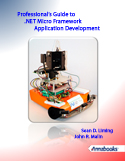
 |
 |
 |
 |
 |
 |
 |
 |
 |
Professional's Guide To .NET Micro Framework Application Development |
|||||
|
|
By John R. Malin and Sean D. LimingThe Microsoft .NET Micro Framework brings Microsoft’s embedded expertise to resource-constrained devices, allowing device makers to bring products to market faster and at lower cost. TCP/IP and Web Services for devices functionality makes the .NET Micro Framework a compelling platform for a new generation of smart, connected, service-oriented devices. Its compact footprint (as little as 64 kilobytes) and support for 32-bit embedded processors without an MMU help keep per-device costs low, and a managed driver model makes it easier to develop device drivers. .NET Micro Framework applications are written in C# using either Visual Studio 2010 or Visual® C# Express 2010 Edition. Professional’s Guide to .NET Micro Framework Application Development provides the most advanced treatment of the .NET Micro Framework SDK available. Over 40 hands-on exercises guide the developer through the tools and APIs available in the .NET Micro Framework SDK. Nineteen chapters cover the basic operation, hardware I/O support, basic networking, graphical interfaces, storage, and the final sample projects to tie the different features together. Example Visual Studio® projects are available for the most popular .NET MF platforms on the market. Features include:
|
||||
|
|
Book Details: Publisher: Annabooks (June 8, 2012) Printed edition is in full color and big format size: 8.5in x11in. (Out of Print) eBook Edition:
|
||||
|
|
|||||
Software Requirements
|
|||||
Hardware RequirementsPlatform running .NET Micro Framework - www.netmf.com. Several .NET Micro Framework platforms were used for the different coding examples:
|
|||||
|
|
Downloads:Book Exercises - Zip file contains files for use with exercises and Visual Studio 2010 source code projects.
|
||||
Table of Contents |
|||||
|
SECTION 1 – INTRODUCTION AND C# BASICS 1 WELCOME SECTION 2 – .NET MICRO FRAMEWORK SDK AND THE
PROCESS LOOP SECTION 3 – HARDWARE I/O SECTION 4 – GRAPHIC USER INTERFACE SECTION 5 – STORAGE SECTION 6 – PROJECTS 17 MIGRATE APPLICATIONS TO A NEW PLATFORM
|
|||||
|
Please review our refund policy before buying. |
|||||
